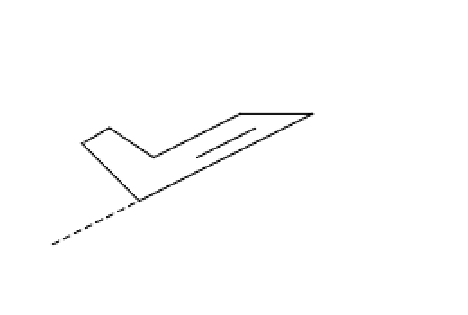Game Development Reference
In-Depth Information
Figure 10-20.
Force diagram for an airplane that is climbing
For the purposes of analyzing full-body aerodynamics, the lift force,
F
L
, as shown in
Figure 10-20 will be defined as the aerodynamic force component that acts perpendicular to
the velocity vector of the airplane. Similarly, the drag force,
F
D
, is defined as the aerodynamic
force component that acts parallel to the velocity vector. For the purposes of this analysis, the
thrust force from the engine,
F
T
, acts parallel to the velocity vector as well. The net force in the
direction parallel to the velocity vector is equal to the thrust force minus the drag force,
F
T
-
F
D
.
Because the airplane is climbing, it will have both vertical and horizontal velocity compo-
nents. The
climb angle
is the angle between the flight path of the airplane and the ground. The
pitch angle
of the airplane is the angle between the longitudinal axis of the airplane and the
ground. In Figure 10-20 the pitch and climb angles are the same, but this will not always be the
case. The angle of attack of the wing is equal to the sum of the pitch and incidence angles minus
the climb angle. A wing on an airplane in straight-and-level flight with a pitch angle of 5 degrees
will have the same angle of attack as when the airplane is at a pitch angle of 15 degrees while
climbing at an angle of 10 degrees.
As was previously mentioned, the thrust and drag forces act along the flight path of the
airplane. Thrust acts in the forward direction and drag acts in the backward direction. The net
thrust on the airplane is equal to the difference between the thrust and drag forces. The lift
generated by the airplane acts in a direction perpendicular to the flight path. Using the climb angle
and the schematic shown in Figure 10-20, the net force acting on the airplane can be expressed
in terms of vertical,
F
z
, and horizontal,
F
x
, components. The angle,
f
, in Equations (10.27)
and (10.28) is the climb angle.
(
)
Fma FF
==−
sin
f
+
F
cos
f
−
W
(10.27)
z
z
T
D
L
(
)
Fma FF
==−
cos
f
−
F
sin
f
(10.28)
x
x
T
D
L
Turning
A standard way to change the direction an airplane is traveling is to perform a banking turn.
The ailerons on the wing are deflected, causing the airplane to roll or bank to one side. As
shown in Figure 10-21, when this happens, the lift force vector is rotated by the bank angle,
y
.






















